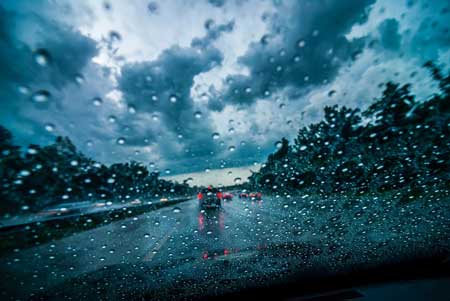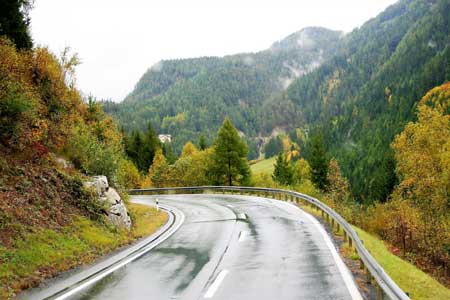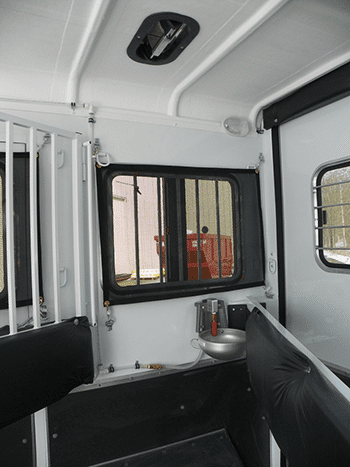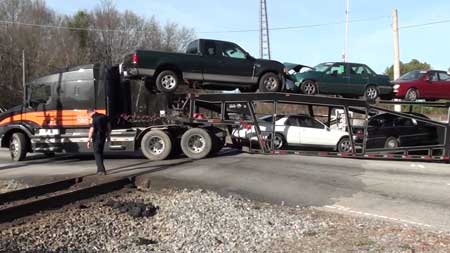How to Haul a Horse Trailer in Bad Weather or Rough Terrain

For each of these cases, be prepared with a few bits of knowledge to will ensure you and your horses arrive home safely. Here are our top tips for driving your horse trailer when the going gets tough …
Wet Roads - Proceed with Caution

Remember you are hauling a very heavy load behind your tow vehicle. Give yourself plenty of extra time to brake when it is raining. Also, travel a lower speed and take all turns more carefully.
Brad Heath, owner of Double D Trailers, cautions, “In the case of heavy rain, hydroplaning on a back road is pretty common. If you’re towing an extra few thousand pounds of trailer, you could lose control pretty quickly.”
The key is to avoid a sliding situation altogether and that comes with sensible driving. If it is pouring buckets, pull over in a safe area to wait out the storm.
Icy Roads - Postpone Your Trip
Four words … “Don’t drive on ice.” It just isn’t worth the risk. There is absolutely no way to maintain control on ice.
All of the problems associated with driving on wet roads are only compounded when ice is thrown into the equation. It’s going to take you even longer to stop in the case of an emergency and you are much more likely to lose control around curves.
If you are setting out on a trip and you see the temperature is going to be low and the roads wet, we definitely recommend you postpone your trip. That way you do not find yourself in a very dangerous situation when the roads begin to freeze over.
Traveling Up and Down Steep Hills or Mountains

On the way up a hill, drive in the right hand lane so faster traffic can go around you. Most tow vehicles will have a “tow or haul” setting or a lower gear available. Use this setting so your tow vehicle doesn’t strain. Never tow up a hill while in “overdrive” because your transmission is likely to overheat in this very high gear.
While traveling down a steep hill or mountain road, shift your tow vehicle into a lower gear. This is better than simply standing on your brakes. A lower gear setting will let the engine itself slow you down while using the trailer and tow vehicle brakes as little as possible.
Protecting Your Horses During Extreme Heat or Cold

Your type of trailer is also going to play an important role. The horse area of the trailer should be insulated on both the ceiling and walls. The roof of your horse trailer should be made of a material other than single layer mill-finish aluminum. (These types of roofs are the absolute WORST when it comes to transferring heat into your trailer.)
The Double D Trailers SafeBump roof system is a single piece fiber composite material that helps regulate the interior temperature on the hottest of days. In addition, the ceiling of the trailer is painted white to help reflect light and heat.
When the temperature is extremely cold, make sure all of the windows, vents, and fans are not blowing excess air onto your horses. We certainly do not recommend you haul your horse in an open-sided stock trailer during excessively cold days.
If you choose to put blanket on your horse, check on them often to make sure they are not overly hot. A sweaty horse in cold temperatures could become chilled very quickly. It may be a better idea to simply let their thick winter coat keep them warm.
Finally, if you are hauling in extreme hot or cold, double check the air pressure in your trailer tires. Air contracts and expands when the temperature changes, so you may need to add or release air from your tires to maintain proper tire pressure.
Don’t Get Stuck on Rough Terrain
Most of the time, you will be driving your horse trailer over paved roads and highways. Barring the occasional pot hole or construction area, you will be on smooth asphalt. If it is safe for your tow vehicle to drive over a road, it will be fine for your trailer as well.
But, what happens when you need to leave the road to drive onto the show grounds or the dirt road leading to your trail head? Then, it’s time to take a bit more care with your driving.
Brad explained, “One thing you have to be careful with on the larger or longer living quarters horse trailers or gooseneck horse trailers is the long wheel base. It can cause the center of the trailer to drag over humps, dips and other uneven terrain.”

To illustrate this point, take a look at this tractor trailer that got wedged into place while trying to drive over a railroad crossing. (image right)
Find an alternate route if you encounter an obstacle like this while hauling a horse trailer with a very long wheel base.
High Winds - Be Prepared for Strong Gusts
At first glance, wind may not seem like much of a threat, but we’ve heard stories of tractor trailers in the western United States getting flipped over by extreme gusts of wind. A horse trailer doesn’t sit nearly as high off the ground as a big rig freight truck, but they are tall enough — and can catch enough wind — to make it difficult to keep control.
The first way to deal with high winds while driving with a horse trailer is to be prepared. Check the weather ahead of time so you are not taken off guard when a huge wind gust suddenly makes the steering wheel jerk out of your hands. Keep both hands on the wheel and be careful not to overcorrect when the wind blows the tow vehicle one way or another.
Regardless of the situation, use your common sense. You have horses standing in the back of your trailer who need to adjust their balance to deal with ever dip, turn, or speed change. Just take extra precautions and check the roadways and weather conditions before you depart. Then, enjoy your trip!
If you have any questions about horse trailer safety in during bad weather or on rough terrain, feel free to send us a note or comment below!

